Anticuchos – Peruvian Grilled Beef Heart Skewers
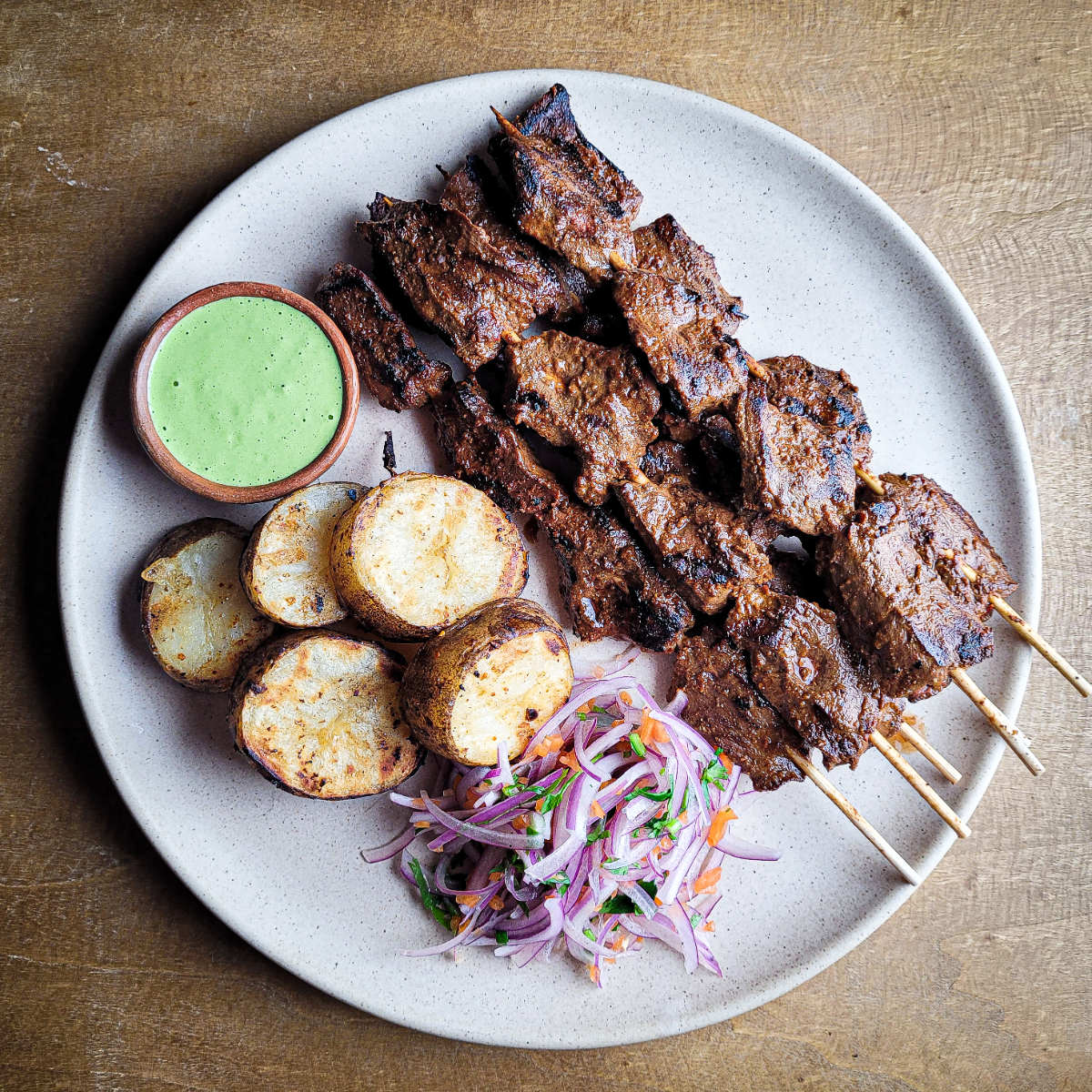
If you have never tasted grilled beef heart, chances are you may be a bit apprehensive at first. Most organ meat typically has a flavor and texture that is quite different from typical beef muscle (steak). Some organs such as the liver may have a strong, irony flavor. Fortunately, one could easily be tricked into thinking they were eating a regular piece of grilled “steak” when they are served Anticuchos. I am personally guilty of serving anticuchos to friends without telling them it is beef heart. They are always surprised by how delicious it is.
“Anticuchos” are a Peruvian dish of marinated chunks of beef heart that are skewed and grilled, similar to shish kebabs. They are often served with some potatoes, maybe some corn, and a sauce or two to accompany. They are typically eaten as a snack or as an appetizer and can be found in restaurants and street carts throughout Peru. In this recipe I will show you how to make some grilled potatoes, as well as two delicous sauces/condiments to accompany the anticuchos.
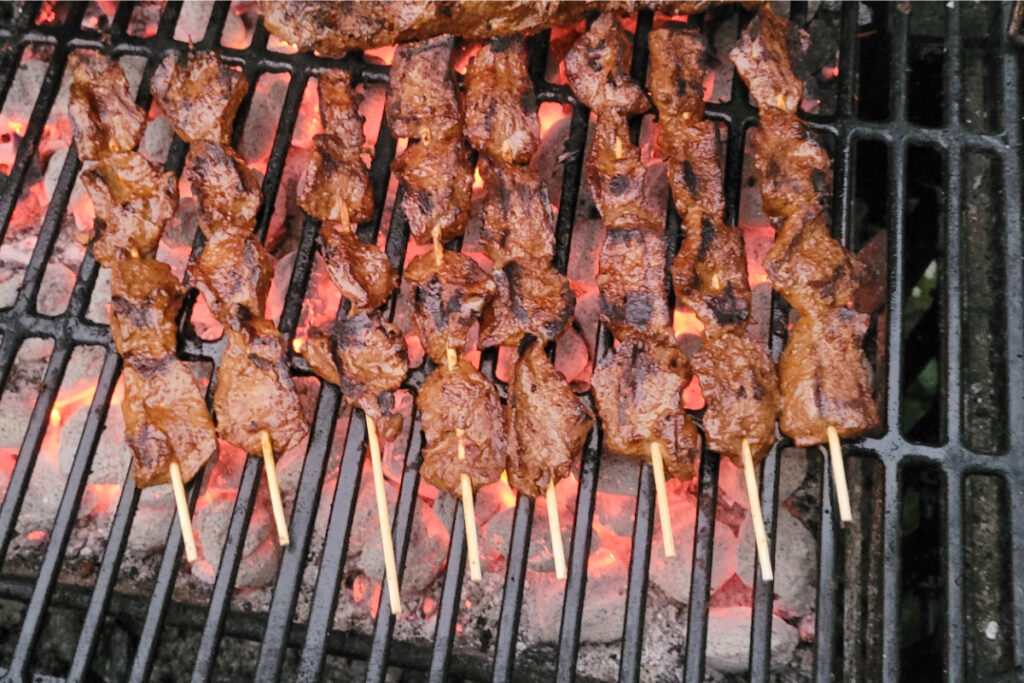
Beef Heart?
Anticuchos are traditionally made with beef heart and if you can find some, I highly recommend you try it. If you cannot find beef heart, any other steak cut will work very well in this recipe. Ask your butcher if they have beef hearts available. They usually keep them frozen which is perfect. They are sometimes already cut into halves or quarters but I will explain how to process the heart if you get it whole.
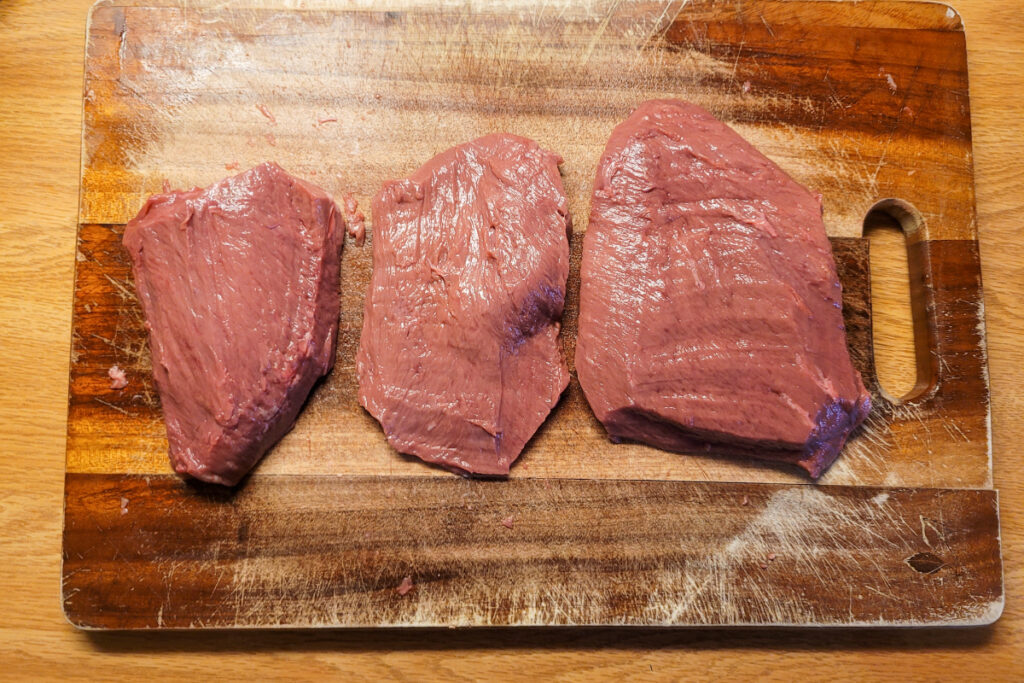
Round Out Your Peruvian-ish Dinner With:
- Fluke Ceviche with Coconut Milk, Corn, and Tomatoes
- Crispy Yucca Fries with Yuzukosho Aioli
- Fried Sweet Plantains
- Fried Green Plantains with Jalapeno-Cilantro Sauce (almost the same sauce as in this recipe)
- Ceviche with Aji Amarillo
- Lomo Saltado
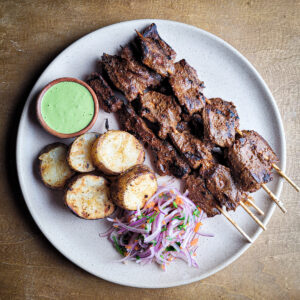
Anticuchos – Peruvian Grilled Beef Heart Skewers
Equipment
- Wooden Skewers
- Blender
- Grill or cast iron pan
Ingredients
Green Sauce (yields 2 cups of sauce)
- 2/3 cup sliced jalapeno, with or without seeds, depending on your preference for heat 75 grams
- 1 large clove garlic 6 grams
- 6 cups roughly chopped cilantro, leaves and stems 200 grams
- 1.5 cups mayonnaise
- 3 Tbsp fresh lime juice
- 1 tsp kosher salt
Salsa Criolla
- 1 medium red onion, thinly julienned
- 5 Tbsp finely chopped hot pepper of your choice I used habanero)
- 1/3 cup chopped cilantro, stems and leaves
- 2 Tbsp fresh lime juice
- 1.5 tsp kosher salt (may need less if using table salt or fine salt)
Anticuchos
- 2.5 pounds beef heart, or steak cut of your choice (beef heart can be whole or in pieces)
- 1/2 cup very roughly chopped garlic 55 grams
- 2 tsp ground black pepper 5 grams
- 2 Tbsp freshly ground cumin 12 grams
- 4.5 Tbsp soy sauce
- 1/2 tsp dark soy sauce (optional, its mostly for color)
- 3 Tbsp red wine vinegar
- 3.5 Tbsp neutral flavored cooking oil (canola, vegetable, corn….etc)
- 1 dry ancho chili, stems and seeds removed about 10 grams
- 1 tsp kosher salt 4 grams
To serve
- 2 russet potatoes
- neutral oil, salt, and chili powder or black pepper
Instructions
Green Sauce
- Place all of the ingredients into a blender and blend until smooth.

- Adjust seasoning with more salt and lime juice if necessary. Sauce should be very well seasoned and very bright in flavor. This will make more sauce than you need for this recipe but it goes well on almost everything. It will keep for up to a week in the fridge.

Salsa Criolla
- Place all of the ingredients in a mixing bowl and toss together. Refrigerate until ready to serve.

Anticuchos
- If the beef heart is frozen, thaw overnight in the refrigerator or under cool running water until thawed.

- Steam or gently simmer the whole, unpeeled russet potatoes until completely cooked. You can check if the potato is done if a skewer easily punctures the whole potato. This will take 1- 1.5 hours. I prefer steaming because the potatoes are less likely to break apart. When the potatoes are done cooking, allow the potatoes to cool in the fridge for at least 1 hour or up to overnight.

- Soak the ancho chili in boiling water for 10 minutes.
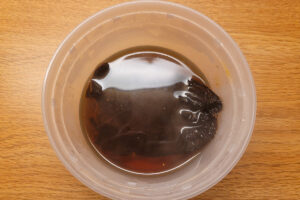
- Soak 6-10 wooden skewers in water for at least 30 minutes, keep them soaking until you are ready to skewer the meat.
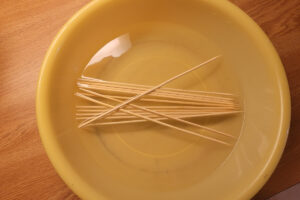
- Note that there are 2 openings (ventricles) in each heart. Try to cut the heart in 3 flat pieces. Two pieces from either side of the heart, and one piece that is the muscle in between the two ventricles. If you have trouble, don't worry because you will be cutting the heart into small chunks anyways.
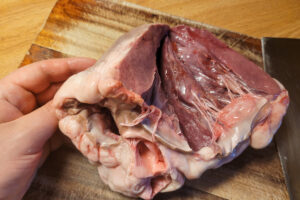
- Here I have removed one side of the heart.
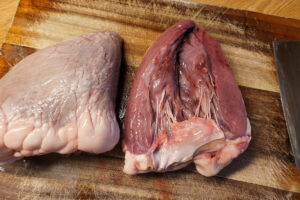
- Here I am separating the other side of the heart from the muscle in between the two ventricles.
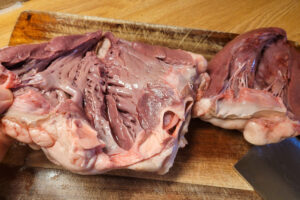
- Take each piece of heart (it doesn't matter how many pieces you ended up with), and use a sharp knife to "shave" away the gnarly-looking, veiny, inner part of the heart.
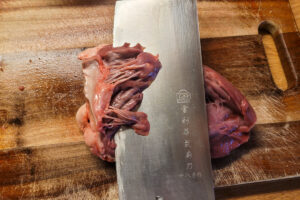
- The heart should look like smooth muscle when you are done.
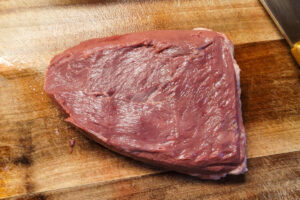
- flip the heart over and cut away any fat on the outside of the heart. If you can carefully peel away the very outer membrane of the heart, awesome. If not, no big deal.
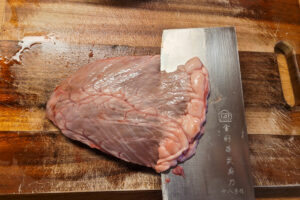
- Repeat this process with the rest of the pieces of heart until they look like clean pieces of meat.
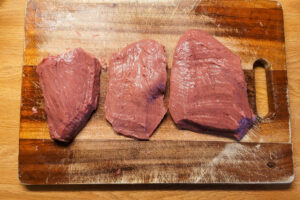
- Cut the beef heart into chunks that are roughly 1.5 inches long and wide but no more than 1/2 inch thick. Set the heart pieces aside in a mixing bowl.
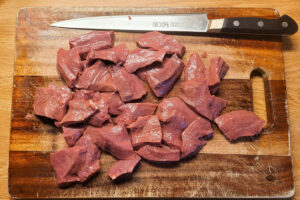
- Remove the ancho chili from the water it was soaking in (discard the soaking water) and place it into the blender with all of the rest of the ingredients listed under "anticuchos" above (not including the heart, obviously). Blend very well.

- Pour the contents of the blender onto the chunks of beef heart and mix well. Cover with plastic wrap and marinate in the refrigerator for a minimum of 3 hours, or up to overnight.
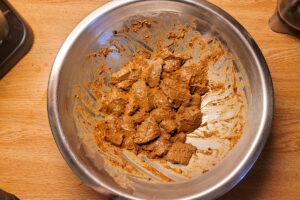
To Serve
- Get a grill hot. Alternatively you could cook the anticuchos in a hot griddle or cast iron pan
- Cut the cooled potatoes into 1 inch thick rounds.

- Season both sides of the potato rounds generously with salt and chili powder (or black pepper). Rub the potatoes generously with neutral oil. Set aside

- Skewer the pieces of marinated beef heart onto the soaked wooden skewers.
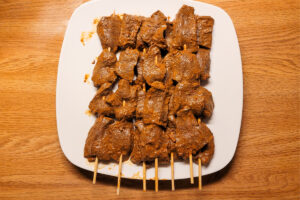
- Grill the potatoes over medium heat for about 4 minutes on each side OR until they are hot and have your desired level of browning/grill marks.

- Place the beef skewers over a hot part of the grill.

- Cook the skewers for about 2-3 minutes on each side, or until they have nice browning. These skewers are delicious cooked anywhere between medium rare and well done, so don't be overly concerned with the doneness. As long as you don't let them cook way past well done (more than 10 minutes) you should be fine.

- Serve the hot skewers immediately with the grilled potatoes, green sauce, and salsa criolla on the side. ENJOY.

This recipe that they put up is completely wrong.. . First it not made with potatoes is made with yucca. No you don’t use habanaro, its made with yellow pepper from perue. Aji amarrio , there is no cilantro in the recipe at all. And not a drop of soy or dark soy a sauce. Thus us not chines food. And where is the aji pannca. Wow you guy messed this up so bad this is not anticuhos …….
Hi Edward,
Sorry you did not like the recipe. A few responses to your concerns …
Anticuchos are very often served with potatoes, less often with yuca.
Salsa criolla is actually more commonly made with aji limo, not aji Amarillo. But the recipe states that you can use any spicy chili you have available, the type of pepper you use has a slight, bit minimal effect in the final product.
My family often put a little cilantro in salsa criolla, maybe yours didn’t? Either way, it is not uncommon to see cilantro in salsa criolla (I am 100% Peruvian by the way).
You are right that most recipes don’t usually call for soy sauce, but mine does. I think it boosts umami and doesn’t drastically change the flavor profile. Also, you may be surprised by how often soy sauce is used in Peruvian food. Pollo a la brasa often uses soy sauce in the marinade. Not to mention the famous lomo saltado and many other dishes.
I agree that aji panca is traditional but it is hard to find the whole dried chilies here in the US besides the pre-made jarred puree, which I find to be of inferior quality. I used ancho chili because is is readily available and you would be surprised that you can’t really tell the flavor difference when it is combined with the garlic and other aromatics.
I think if you tried making the recipe and tasting it you might have a different opinion of whether or not these “are anticuchos”.
Best,
Ian
Loved it!
So glad to hear that!